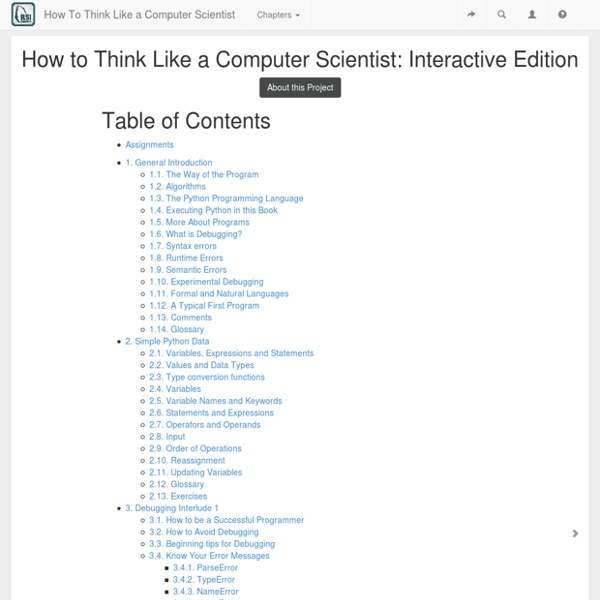Table of Contents — How to Think like a Computer Scientist: Interactive Edition
This interactive book is a product of the Runestone Interactive Project at Luther College, led by Brad Miller and David Ranum. There have been many contributors to the project. Our thanks especially to the following: This book is based on the Original work by: Jeffrey Elkner, Allen B. Downey, and Chris MeyersActivecode based on SkulptCodelens based on Online Python TutorMany contributions from the CSLearning4U research group at Georgia Tech.ACM-SIGCSE for the special projects grant that funded our student Isaac Dontje Lindell for the summer of 2013.NSF The Runestone Interactive tools are open source and we encourage you to contact us, or grab a copy from GitHub if you would like to use them to write your own resources.
BeginnersGuide/NonProgrammers
Python for Non-Programmers If you've never programmed before, the tutorials on this page are recommended for you; they don't assume that you have previous experience. If you have programming experience, also check out the BeginnersGuide/Programmers page. Books Each of these books can be purchased online but is also available as free textual, website, or video content. Automate the Boring Stuff with Python - Practical Programming for Total Beginners by Al Sweigart is "written for office workers, students, administrators, and anyone who uses a computer to learn how to code small, practical programs to automate tasks on their computer." You can find many free Python books online. Interactive Courses These sites give you instant feedback on programming problems that you can solve in your browser. CheckiO is a gamified website containing programming tasks that can be solved in Python 3. Resources for Younger Learners Tutorials and Websites Tutorial Aggregators / lists Apps Videos Email Academies Tools
Basic Operators - Learn Python - Free Interactive Python Tutorial
This section explains how to use basic operators in Python. Arithmetic Operators Just as any other programming languages, the addition, subtraction, multiplication, and division operators can be used with numbers. number = 1 + 2 * 3 / 4.0 Execute Code Try to predict what the answer will be. Another operator available is the modulo (%) operator, which returns the integer remainder of the division. dividend % divisor = remainder. remainder = 11 % 3 Using two multiplication symbols makes a power relationship. squared = 7 ** 2 cubed = 2 ** 3 Using Operators with Strings Python supports concatenating strings using the addition operator: helloworld = "hello" + " " + "world" Python also supports multiplying strings to form a string with a repeating sequence: lotsofhellos = "hello" * 10 Using Operators with Lists Lists can be joined with the addition operators: even_numbers = [2,4,6,8] odd_numbers = [1,3,5,7] all_numbers = odd_numbers + even_numbers print [1,2,3] * 3
InMusic
This page is divided in three sections: Music software written in Python, Music programming in Python, and Music software supporting Python Bluemindo - Bluemindo is a really simple but powerful audio player in Python/PyGTK, using Gstreamer. Bluemindo is a free (as in freedom) software, released under GPLv3, only. cplay - a curses front-end for various audio players edna - an MP3 server, edna allows you to access your MP3 collection from any networked computer. The web pages are dynamically constructed, adjusting to directory structure and the files in those directories. This is much nicer than using simple directory indexing.
Dive Into Python 3
Python Introduction Tutorial
First, off Python usually requires some setup by downloading the Python IDLE. The Python IDLE is basically a text editor that lets you execute Python code. If you want to use Python as a server-side language, you certainly can. Python can output HTML just like other languages can, but Python is more commonly used as a module rather than intertwined like some PHP or ColdFusion. As for right now, I recommend you download the IDLE to help you debug your code while we learn the fundamentals offline. You can see right off the bat, that we use print() a whole lot. See how simple that was? For a more tangible and better look into the Python language, consider reading the following book. Your code will execute in this window. Let's explore some more tutorials or topics! Next Tutorial Previous Tutorial If you enjoyed this resource, support me by sharing this page with others.
Related:
Related:



